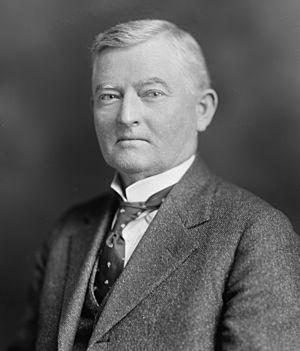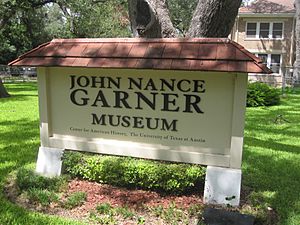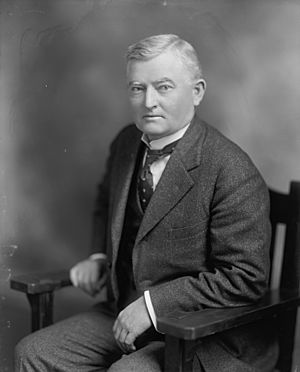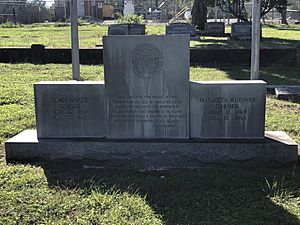John Nance Garner facts for kids
Quick facts for kids
John Nance Garner
|
|
|---|---|

Garner, c. 1930s
|
|
| 32nd Vice President of the United States | |
| In office March 4, 1933 – January 20, 1941 |
|
| President | Franklin D. Roosevelt |
| Preceded by | Charles Curtis |
| Succeeded by | Henry A. Wallace |
| 39th Speaker of the United States House of Representatives | |
| In office December 7, 1931 – March 3, 1933 |
|
| Preceded by | Nicholas Longworth |
| Succeeded by | Henry Rainey |
| House Minority Leader | |
| In office March 4, 1929 – March 3, 1931 |
|
| Preceded by | Finis Garrett |
| Succeeded by | Bertrand Snell |
| Leader of the House Democratic Caucus | |
| In office March 4, 1929 – March 3, 1933 |
|
| Preceded by | Finis J. Garrett |
| Succeeded by | Henry Thomas Rainey |
| Member of the U.S. House of Representatives from Texas's 15th district |
|
| In office March 4, 1903 – March 3, 1933 |
|
| Preceded by | Position established |
| Succeeded by | Milton H. West |
| Member of the Texas House of Representatives from the 91st district |
|
| In office January 10, 1899 – January 13, 1903 |
|
| Preceded by | Sam Jones |
| Succeeded by | Ferdinand C. Weinert |
| County Judge of Uvalde County | |
| In office 1893–1896 |
|
| Preceded by | A. V. D. Old |
| Succeeded by | J. E. Cummings |
| Personal details | |
| Born |
John Nance Garner III
November 22, 1868 Red River County, Fifth Military District, U.S. |
| Died | November 7, 1967 (aged 98) Uvalde, Texas, U.S. |
| Resting place | Uvalde Cemetery Uvalde, Texas, U.S. |
| Political party | Democratic |
| Spouse |
Mariette Rheiner
(m. 1895; died 1948) |
| Children | 1 |
| Education | Vanderbilt University |
| Signature | |
John Nance Garner III (born November 22, 1868 – died November 7, 1967) was an important American politician and lawyer from Texas. Many people knew him as "Cactus Jack." He served as the 32nd Vice President of the United States under President Franklin D. Roosevelt from 1933 to 1941. Before that, he was the 39th Speaker of the United States House of Representatives from 1931 to 1933. John Nance Garner and Schuyler Colfax are the only two politicians who have been both Speaker of the House and Vice President.
Garner started his political journey as a county judge in Uvalde County, Texas. He then served in the Texas House of Representatives and later represented Texas in the United States House of Representatives. He was a member of Congress for 30 years. He became the leader of the Democratic Party in the House before becoming Speaker.
In 1932, Garner ran for president but agreed to become Franklin D. Roosevelt's running mate. They won the election and were re-elected in 1936. Garner was a conservative politician, meaning he often preferred traditional ways. He disagreed with some of Roosevelt's "New Deal" ideas, especially about government spending. However, he was very good at helping new laws pass through Congress. He also made the Vice President's job more active than it had been before. Garner later disagreed with Roosevelt and tried to run for president again in 1940, but Roosevelt won the nomination.
Contents
Early Life and Family History
John Nance Garner was born on November 22, 1868, in a simple log cabin in Red River County, Texas. His parents were John Nance Garner Jr. and Sarah Guest Garner. The log cabin is gone, but the house where he grew up still stands in Detroit, Texas.
Garner went to Vanderbilt University in Nashville, Tennessee, but only for one semester. He then returned home and studied law. He became a lawyer in 1890 and started his practice in Uvalde, Texas, in 1896.
In 1893, Garner decided to enter politics. He ran for county judge of Uvalde County, Texas. This job was the main administrative leader of the county. He ran against a woman named Mariette "Ettie" Rheiner. After he won the election, he started dating Ettie, and they got married in 1895. Garner served as county judge until 1896.
Texas Political Career
Garner was elected to the Texas House of Representatives in 1898 and again in 1900. During his time there, the state legislature was choosing a state flower for Texas. Garner strongly supported the prickly pear cactus for this honor. This is how he earned his famous nickname, "Cactus Jack." However, the bluebonnet was chosen as the state flower instead.
He also wrote a proposal that would have divided Texas into five separate states. This idea passed in the Texas House, but the Governor stopped it.
In 1901, Garner supported a law called the poll tax. This law made it harder for some people to register to vote. It was passed by the Democratic-controlled legislature. This change helped the Democratic Party stay in power in Texas for many years.
Garner traveled around southern Texas, making friends with powerful local leaders. These leaders, sometimes called patróns, had a lot of control over local people and elections. They helped create a special voting district for Garner, the Texas's 15th congressional district. This district was designed to help him win elections easily.
Serving in the U.S. House of Representatives
John Nance Garner was first elected to the United States House of Representatives in 1902. He was re-elected 14 more times, serving in Congress until 1933. His wife, Mariette, worked as his private secretary during these years. He always stayed loyal to the white landowners who controlled voting in South Texas.
In 1929, Garner was chosen to be the minority floor leader for the Democrats. This meant he was the main leader of his party when they were not in control of the House. In 1931, when Democrats won more seats, he became the Speaker of the United States House of Representatives. The Speaker is the leader of the entire House.
Garner supported the federal income tax. However, he was against most tariffs (taxes on imported goods), except for those on wool and mohair. These were important products in his home state of Texas. He also believed in investing government money in rural areas to help farmers.
Vice Presidency (1933–1941)
In 1932, Garner wanted to become the Democratic candidate for president. However, Franklin D. Roosevelt, the Governor of New York, was the strongest candidate. Roosevelt had many delegates, but not quite enough to win the nomination on his own. Garner made a deal with Roosevelt, agreeing to be his running mate (Vice President). This helped Roosevelt win the nomination.
Garner was elected to Congress again on November 8, 1932. On the same day, he was also elected Vice President of the United States. He was the second person in history, after Schuyler Colfax, to serve as both Speaker of the House and Vice President. Garner was re-elected Vice President with Roosevelt in 1936. He served as Vice President from March 4, 1933, to January 20, 1941.
Unlike many vice presidents before him, Garner took a more active role. He attended Roosevelt's Cabinet meetings and helped with national policy and legislative plans. This changed the Vice President's job from mostly ceremonial to more involved.
However, during Roosevelt's second term, Garner's relationship with the president became difficult. Garner disagreed with Roosevelt on many important issues. He supported stopping labor strikes and believed the government should balance its budget. He also opposed Roosevelt's plan to add more judges to the Supreme Court. Garner felt that the federal government was gaining too much power.
In 1938 and 1939, many Democratic leaders encouraged Garner to run for president in the 1940 United States presidential election. Garner was seen as a leader for the traditional Democratic Party, which often disagreed with Roosevelt's "New Deal" programs. Polls showed that Garner was popular among Democratic voters, especially because people thought Roosevelt would not run for a third term.
Garner announced his candidacy for president. Roosevelt did not say if he would run again. If Roosevelt did run, it would be very hard for Garner to win. Still, Garner stayed in the race. He disagreed with some of Roosevelt's "New Deal" policies. He also believed that presidents should not serve more than two terms.
At the 1940 Democratic National Convention, Roosevelt decided to run for a third term and won the nomination. Garner only received a small number of votes. Roosevelt then chose Henry A. Wallace as his new running mate.
Life After the Vice Presidency (1941–1967)
John Nance Garner left office on January 20, 1941. This marked the end of his 46-year career in public service. He moved back to his home in Uvalde, Texas. For the next 26 years, he managed his properties, spent time with his great-grandchildren, and enjoyed fishing. Even in retirement, active Democratic politicians often asked for his advice. He was especially close to President Harry S. Truman, who took over after Roosevelt.
On the morning of Garner's 95th birthday, November 22, 1963, President John F. Kennedy called him to wish him a happy birthday. This call happened just a few hours before Kennedy's assassination later that day.
Personal Life and Death
John Nance Garner and Mariette Rheiner started dating after the 1893 election. They got married in Sabinal, Texas, on November 25, 1895. Mariette worked as her husband's secretary throughout his time in Congress. She also served as Second Lady of the United States when he was Vice President. They had one son, Tully Charles Garner (1896–1968), who became a banker.
John Nance Garner died on November 7, 1967, just 15 days before his 99th birthday. He died from a heart condition. Garner holds the record as the longest-lived Vice President in United States history.
Legacy and Recognition

Several places are named after John Nance Garner. Garner State Park, located about 30 miles (48 km) north of Uvalde, bears his name. Garner Field, an airport east of Uvalde, is also named after him. The women's dormitory at Southwest Texas Junior College in Uvalde is named after his wife, Mariette. John Garner Middle School in San Antonio is also named in his honor.
Garner and Schuyler Colfax are the only two Vice Presidents who also served as Speaker of the House of Representatives. Since the Vice President is also the President of the Senate, this means Garner and Colfax are the only people to have led both houses of Congress.
Images for kids
See also
 In Spanish: John N. Garner para niños
In Spanish: John N. Garner para niños




